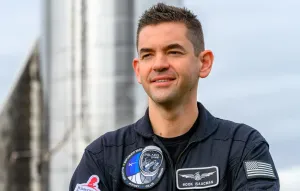
Mar 4, 2024
SpaceX launches Crew-8 to the International Space Station
At 03:53 am, Universal Coordinated Time, a Falcon 9 lifted off from Launch Complex 39A with Crew Dragon Endeavor atop of it carrying four astronauts onboard for the Crew-8 mission. The four astronauts are Commander Matthew Dominick, Pilot Michael Barratt, Mission Specialist Jeanette Epps, and Mission Specialist Alexander Grebenkin.
Crew Dragon Endeavor, which is carrying the four astronauts, is expected to dock at the International Space Station approximately twenty-eight hours after it lifted off, which is approximately 08:00 am Universal Coordinated Time. Crew-8 is expected to spend six months onboard the space station before they return to Earth, which is currently planned for August.

Crew-8 will also be relieving Crew-7 of their duties aboard the space station as they prepare to return to Earth this month. The four astronauts of Crew-7 have been on the space station since August of 2023. That mission is flying Crew Dragon Endurance and the crew consists of Konstantin Borisov, Andreas Mogensen, Jasmin Moghbeli, and Satoshi Furukawa.
This is the eighth operational NASA Commercial Crew Program mission to take place and the ninth overall with the Demo-2 mission. So far SpaceX has flown all of these missions.
While onboard the International Space Station as part of Expeditions 70 and 71 missions the crew will perform experiments on stem cells to create organoid models to study degenerative diseases, study the effects of microgravity and Ultraviolet radiation on plants at a cellular level, and test if wearing pressure cuffs on the legs could prevent fluid shifts and reduce health problems for astronauts.
The Crew Dragon capsule for this mission, Endeavor, is heading to space for the fifth time having previously supported the Demo-2, Crew-2, Crew-6, and Ax-1 missions. The booster for this mission was flying for the first time and landed back at Landing Zone 1, this booster is B1083.

Who's onboard?
Matthew Dominick
Matthew Dominick is the Commander of the Crew-8 mission, which is also his first trip to space. Dominick was selected by NASA to join the 2017 Astronaut Candidate Class and became one in August of 2017.

Matthew Dominick graduated from D’Evelyn High School in Golden, Colorado. Earned a Bachelor of Science in Electrical Engineering from the University of San Diego with minors in Physics and Mathematics. Earned a Master of Science in Systems Engineering from the Naval Postgraduate School in Monterey, California. As well as graduating from the U.S. Naval Test Pilot School in Patuxent River, Maryland.
Dr. Michael Reed Barratt
Dr. Michael Reed Barratt is the Pilot of the Crew-8 mission, this is his third trip to space having previously flown on the Soyuz TMA-14 and STS-133 missions. Barratt was selected by NASA in 2000 as an astronaut and first flew in 2009.

Dr. Michael Reed Barratt graduated from Camas High School, Camas, Washington, in 1977. Obtained a Bachelor of Science in Zoology, University of Washington, in 1981. Became a Doctor of Medicine from Northwestern University, in 1985. Barratt completed a three-year residency in Internal Medicine at Northwestern University in 1988. Also, completed a Chief Residency year at Veterans Administration Lakeside Hospital in Chicago in 1989. As well as completing a residency and Master’s program in Aerospace Medicine at Wright State University in 1991. He is also certified in Internal and Aerospace Medicine.
Jeanette J. Epps
Jeanette J. Epps is a Mission Specialist for the Crew-8 mission, which is her first trip to space. Epps was selected by NASA in 2009 as an astronaut.

Jeanette J. Epps graduated from Thomas J. Corcoran High School, Syracuse, New York in 1988. Obtained a Bachelor of Science in Physics, LeMoyne College, 1992. Achieved a Master of Science and Doctorate of Philosophy in Aerospace Engineering, University of Maryland, 1994 and 2000.
Alexander Grebenkin
Alexander Grebenkin is a Mission Specialist for the Crew-8 mission, which is his first trip to space. Grebenkin was selected as a cosmonaut candidate in August of 2018 and completed training in December of 2020.

Alexander Grebenkin graduated from Irkutsk High Military Aviation School, Irkutsk, Russia, majoring in engineering, maintenance, and repair of aircraft radio navigation systems in 2002. He also graduated from Moscow Technical University of Communications and Informatics with a degree in radio communications, broadcasting, and television in 2011.
What is Crew Dragon?
Crew Dragon, or Dragon 2, is a partially reusable spacecraft developed by SpaceX. The primary use for Crew Dragon is to send crew to and from the International Space Station. SpaceX has also flown a free flight of the spacecraft and is planning another for the second half of 2024.

Crew Dragon consists of the capsule and trunk. The trunk is used to store unpressurized cargo as well as have solar panels mounted on one side, to generate power, and radiators on the other, to dissipate heat generated inside. The trunk is not reused and burns up in the atmosphere after each mission. The capsule is where the crew will be during launch, landing, and while on their way to space. Unlike the original Dragon capsule, the Crew Dragon capsule has a launch abort system consisting of eight SuperDraco engines. The capsule also has a nosecone that will fold out of the way in space to protect the docking hardware and forward-facing thrusters during launch and landing. The forward-facing thrusters are the main propulsion system for performing maneuvers while in flight.
Crew Dragon was developed as part of NASA's Commercial Crew Program to regain crew access to the International Space Station from the United States of America after the retirement of the Space Shuttle. SpaceX currently has four active Crew Dragon capsules; Endeavour, Resilience, Endurance, and Freedom. A fifth Crew Dragon capsule is under construction and is expected to be finished in 2024.



